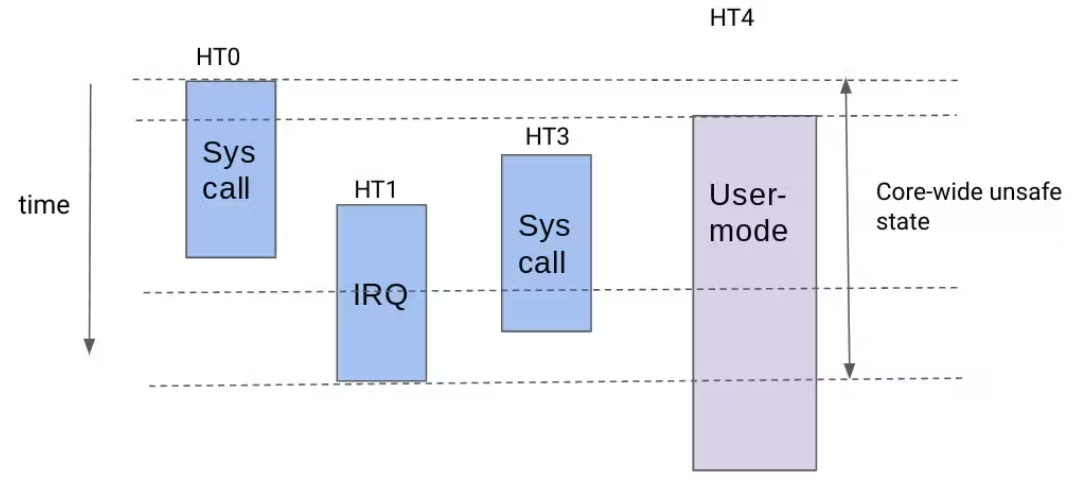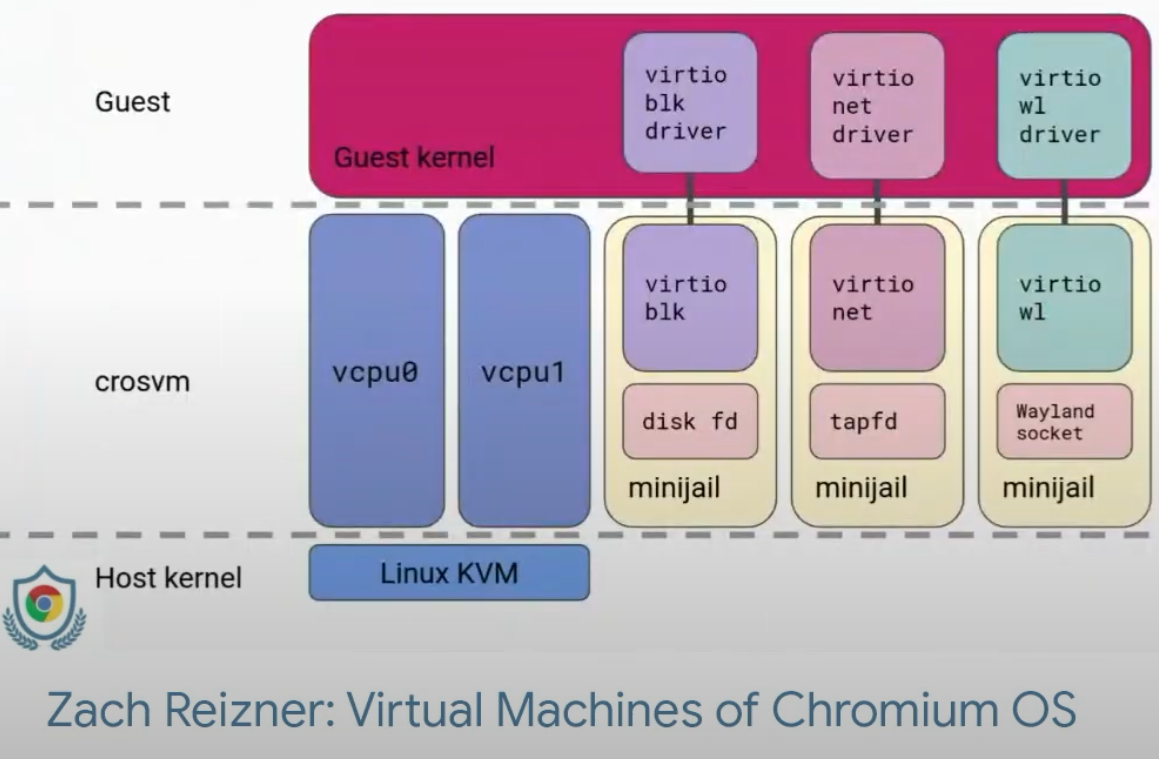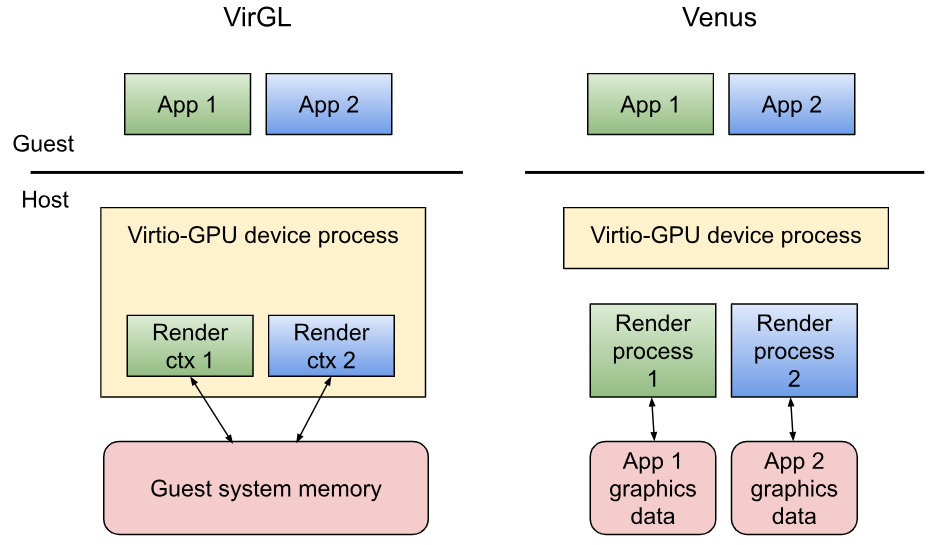Note: as of 2025 05 20 this website won't be updated anymore. Consider inactive unless stated otherwise.
Netrunner Archive - ChromeOS
ChromeOS is the most secure consumer desktop OS currently on the market. It employs an extremely extensive defence-in-depth security model and has a detailed Whitepaper on it. 1
Update Cycle
ChromeOS follows the weekly Chrome release cycle.2 This can be verified by checking the Chrome updates page which shows ChromeOS getting weekly stable updates.
Android Runtime on ChromeOS (ARCVM)
ChromeOS has undergone significant advancements in running Android apps through three iterations of Android Runtime for ChromeOS (ARC)3:
The image below showcases the architectural differences between ARC++ and ARCVM.

ARCVM achieves a clean separation between ChromeOS and Android by running Android within a virtual machine (VM). This isolation reduces dependencies and simplifies updates for each system. Let's look at the ARCVM kernel as an example.
ARCVM Kernel
The ARCVM kernel is a single, unified kernel (available for both x86_64 and aarch64 architectures) that comes bundled with ARCVM. It's a customized version of the Android Common Kernel (ACK) with specific patches to ensure smooth integration with the host OS (ChromeOS in this case). An example of such a patch is Virtio support for Wayland, which facilitates graphics communication.
source
While Google doesn't publicly disclose the specific hardening measures implemented in the ARCVM kernel, the open-source nature of ChromiumOS, the foundation for ChromeOS, provides valuable insight. By examining the ChromiumOS ARCVM git repos, we can identify the security features incorporated into the kernel.
These features will be documented to the best of our ability in the future.
Venus
Venus is an efficient framework for virtualized vulkan. Refer to Venus for more information.
Future ARCVM Work
Using KVM-based VMs on battery-powered devices like Chromebook is not common and still has some unexplored areas that we can improve.
For example, memory usage optimization is critical since our devices have far less RAM than traditional KVM deployments on massive servers. Applying multi-generational LRU (MGLRU) was a huge win for our memory usage.
Additionally, we have an experimental project called ManaTEE which pushes VM usage forward and provides software-based Trusted Execution Environments (TEEs) without dedicated TEE hardware. This opens up an opportunity for us to store data which should not be exposed even to the host OS, such as biometrics and encryption keys.
source
Manatee is under active development by Google, but as of June 23, 2024 it is not yet used in production. For those interested, take a look at the ChromiumOS ManaTEE git repo and the BlinkOn conference presentation YouTube video which explains what ManaTEE is and how it works.
Linux Dev Env (Crostini)
The majority of security features for Crostini are used for ARCVM as well. See CrosVM for detailed documentation.
Chunnel
chunnel tunnels traffic for servers that listen on localhost. This is a common developer use case since localhost is allowed as a secure origin in Chrome.
The chunneld binary runs on the Chrome OS host, and receives updates from vm_cicerone notifying it of ports that should be listened to. When Chrome connects to localhost:port, chunneld will accept the connection, open a vsock listener, and launch the chunnel binary in the target container which will connect back to chunneld.
source
Virtio-Wayland
Uses a custom virtio-based protocol. The device implementation is in CrosVM while the driver implementation is in the guest kernel. CrosVM makes host-side wayland connections, buffers, and pipes on behalf of the guest kernel.
There is also a user-space component called Sommelier
Implementing X11 over wayland usually means the compositor gives X11 applications extra privileges which ordinary wayland applications don't have. Sommelier doesn't grant applications those privileges, but rather tricks them into thinking they have them. This is to keep good security while being very useful.
LXD
Run by Maitred. Responsible for downloading, creating and running containers. While the default is a Crostini-flavoured Debian, any Linux distribution that LXC supports can be used (Arch, Gentoo, Kali, etc.).
Termina
Read-only, dm-verity verified. Downloaded, updated and verified by component updater. Termina is the ChromeOS "baseboard", tatl for x86, tael for ARM.
Tremplin
Tremplin is the “springboard” daemon that runs in the Termina VM and exposes a gRPC interface for managing LXD containers.
Limitations
Notificationd
notificationd is a new daemon which catches the notification request from Crostini apps via D-BUS and forwards it to Chrome OS (host) via Wayland.
source
Upgrade Container
upgrade_container is executed inside a container by Tremplin to upgrade e.g. a Debian Stretch container to Debian Buster.
source
Core Scheduling
Recent CPU vulnerabilities, particularly those targeting hyperthreading, have highlighted security risks. The discovery of Microarchitectural Data Sampling (MDS) attacks, like Rogue In-Fligt Data Load (RIDL) and fallout, allows malicious actors to exploit weaknesses within a CPU core. These attacks enable one hyperthread to glean sensitive data from another by analyzing side-channel information. While disabling hyperthreading is a typical defense against such vulnerabilities, it often comes at the expense of processing speed.4 Google's bug hunters blog has an excellent writeup on MDS attacks for those that want to learn more about MD5 vulnerabilities.
While a brute-force approach of disabling the vulnerable functionality might appear effective for mitigating CPU vulnerabilities, it often incurs a substantial performance penalty.
ChromeOS Core Scheduling Implementation
Core scheduling in ChromeOS relies on collaboration between user space and the kernel to ensure security and performance. User space defines groups of tasks that are considered trustworthy towards each other. The kernel scheduler then restricts tasks within the same group to share a CPU core's hyperthreads simultaneously. This balancing act optimizes performance by ensuring tasks run efficiently while maintaining fairness. The scheduler dynamically switches between two modes:
The chosen mode depends on the task priorities and compatibility within the group.5
There are three primary users of core scheduling in ChromeOS:6
Addressing Kernel Space Concerns
A theoretical concern exists regarding user space "trusted" processes potentially compromising security. This is because a hyperthread can enter the kernel while its sibling remains in user space. To address this, ChromeOS employs per-CPU counters to monitor a core-wide "unsafe state." This state activates whenever a core's hyperthread transitions to kernel mode. When in this unsafe state, ChromeOS utilizes Inter-processor interrupts (IPI) to temporarily remove all hyperthreads from user space, excluding those already idle. Google's testing demonstrates this mechanism has minimal performance impact.7
The image below shows what this looks like:

CrosVM
ChromeOS utilizes crosvm, a lightweight virtual machine monitor (VMM), to securely run both Linux applications and Android environments. Prioritizing security, crosvm isolates these untrusted environments within sandboxes. Written in Rust, a memory-safe language, crosvm minimizes the risk of vulnerabilities. Each virtual device, like disks and network interfaces, runs within its own minijail sandbox, further restricting potential exploits. This multi-layered approach ensures that even a compromised Linux instance or Android container cannot escape the sandbox and harm the core ChromeOS system. Crosvm strengthens this security by enforcing a syscall security policy, meticulously controlling which system calls guest Linux devices and Android containers can execute.8

Cicerone
vm_cicerone is a system daemon that runs in Chrome OS userspace and is responsible for all communication directly with the container in a VM. It exposes a D-Bus APIfor doing things such as launching applications in containers, getting icons from containers and other container related functionality as it is extended. It also sends out signals for starting/stopping of containers.
Concierge communicates with vm_cicerone to keep the list of running VMs in sync and also to retrieve status of containers and get security tokens.
When cicerone communicates with a container, it is interacting with the garcon component running inside of that container and is doing so over gRPC.
source
Concierge
vm_concierge is a system daemon that runs in Chrome OS userspace and is responsible for managing the lifetime of all VMs. It exposes a D-Bus API for starting and stopping VMs.
When vm_concierge receives a request to start a VM it allocates various resources for that VM (IPv4 address, vsock context id, etc) from a shared pool of resources. It then launches a new instance of CrosVM to actually run the VM.
Once the VM has started up vm_concierge communicates with the maitred instance inside the VM to finish setting it up. This includes configuring the network and mounting disk images.
source
Garcon is a daemon that runs inside of a container within a VM. gRPC is used to communicate between vm_cicerone and garcon. It is used to control/query things inside the container such as application launching, accessibility, handling intents, opening files, etc. The communication is bi-directional. It uses TCP/IP for the transport and firewall rules ensure that only the container IPs are allowed to connect to the corresponding port for garcon that is open in vm_cicerone.
source
Maitred
Maitred is the agent running inside the VM responsible for managing the VM instance. It acts as the init system, starting up system services, mounting file systems, and launching the container with the actual application that the user wants to run. It is responsible for shutting down the VM once the user's application exits or if requested to by vm_concierge.
source
Seneschal
seneschal is the steward of the user's /home directory. It manages processes that serve the 9p file system protocol. The 9p client lives in the guest kernel and communicates with the server over vsock.
Each server initially does not have access to any path but can be granted access to specific paths in the user's home directory by sending requests over dbus to seneschal. These paths are bind-mounted into the server's root directory and become visible to the 9p clients of that server.
This makes it possible to share different sets of paths with different VMs by giving each of them access to a different 9p server.
source
9s
9s is program that serves the 9p file system protocol. Seneschal aunches one instance of this program for each VM started by the user. It is a small wrapper around the p9 rust library.
source
Minijail
Minijail is used extensively within ChromeOS to heavily sandbox and isolate processes. It utilizes namespace isolation, seccomp filtering, ChromeOS permission broker.
SELinux
A lot of SELinux policies are imported from AOSP, see ChromeOS SELinux policies.
Venus
Venus is an efficient framework for virtualized Vulkan, providing the accelerated Vulkan API to ChromeOS guest VM applications. Venus has a lightweight guest-side implementation that streams Vulkan API calls into a shared memory buffer that the host-side renderer asynchronously consumes. Its predecessor, VirGL, in contrast has a guest-side driver that interprets OpenGL calls to synchronously return OpenGL state and error results at the expense of additional CPU overhead.This causes a performance hit twice, once when the renderer interprets and submits those commands to the host, and again for error checking and state tracking, as required by the spec.
One of the big design changes from VirGL is Venus's process isolation. In the event of an attack on the host through the guest graphics API, the Venus architecture limits the attack to the guest application's own graphics data as opposed to the guest OS's system memory.
source
Venus is used for the graphics API in borealis and ARCVM.
